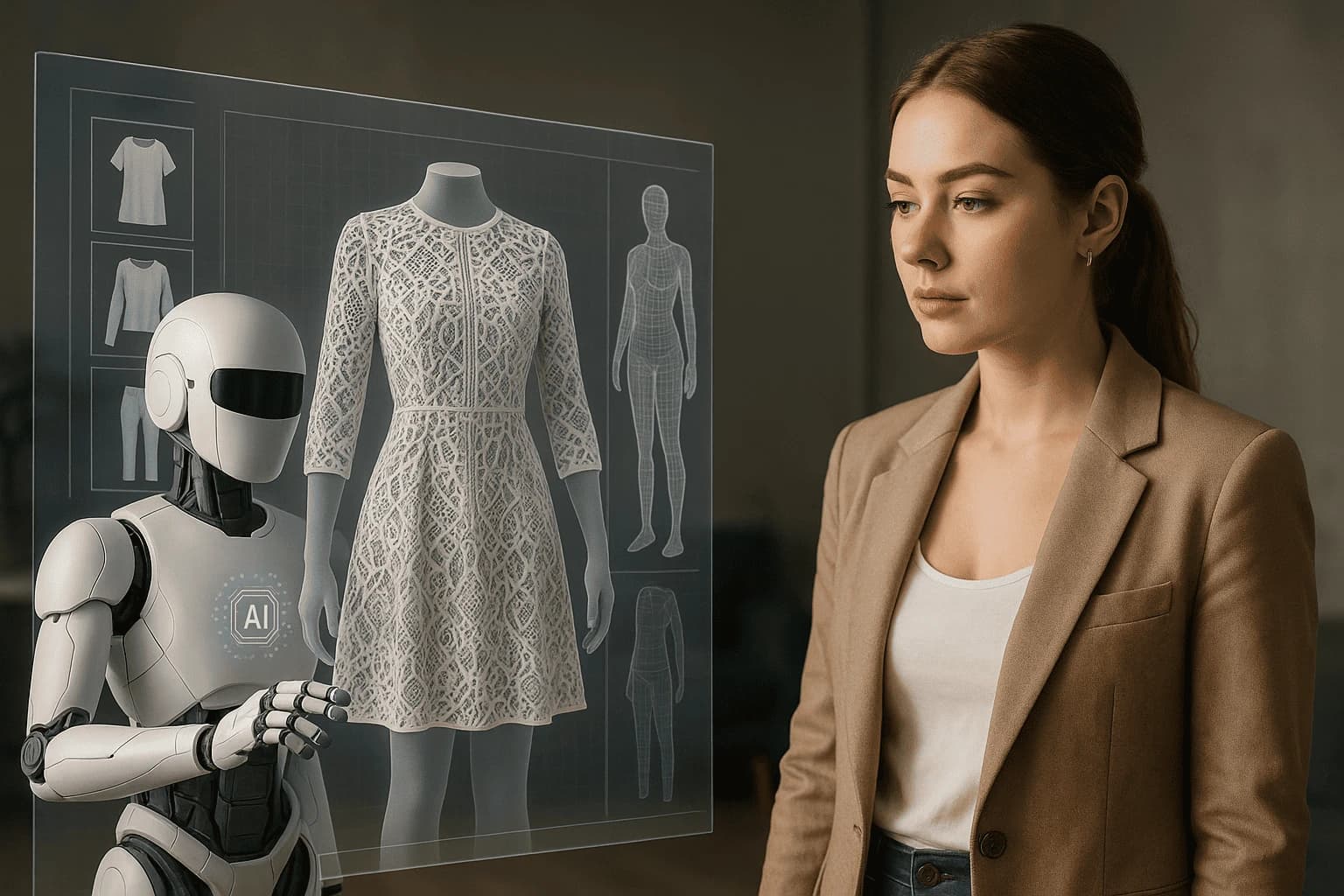
* All product/brand names, logos, and trademarks are property of their respective owners.
In a world where fashion is no longer confined to fabric and runway lights, artificial intelligence (AI) is redefining the industry — one digital stitch at a time. The fusion of technology and fashion has sparked a revolution, and 2025 is shaping up to be the most transformative year yet for digital fashion. From hyper-personalized styling to algorithmically-generated collections, AI is not just assisting designers — it’s becoming the designer.
Generative AI in fashion has evolved beyond buzzwords. It’s helping creators conceptualize garments from scratch, analyze trend data at lightning speed, and simulate collections before a single piece is physically produced. This not only accelerates the creative process but also opens the door for broader inclusivity, allowing emerging designers to compete on a tech-powered playing field.
Equally groundbreaking is the rise of virtual try-on technology. In the past, online shopping felt like a gamble — will it fit, will it suit me? But today, AI-powered fitting rooms and augmented reality (AR) apps allow consumers to see themselves in digital outfits, customize their look, and even get styling suggestions from AI “assistants.” The result? Better confidence, reduced returns, and a more sustainable fashion ecosystem.
As we delve into this blog, we’ll explore how generative design, virtual try-ons, and AI-driven personalization are shaping the digital fashion landscape. Whether you're a designer, tech enthusiast, retailer, or curious shopper — this journey through the future of fashion will show how creativity and code are converging like never before.
Generative design in fashion refers to the use of algorithms and machine learning to autonomously generate patterns, silhouettes, or even entire collections. Instead of starting with a traditional sketch, designers now feed mood boards, data sets, and style preferences into generative AI tools that produce hundreds of design variations in minutes.
This approach allows for rapid ideation and drastically cuts down the time between concept and prototype. The AI analyzes trend data, material behavior, body measurements, and more — then “creates” designs that are not only aesthetically pleasing but also manufacturable. The result is a co-creation process where the designer becomes more of a curator than a creator.
Several tools are already transforming the industry. Platforms like CLO 3D, StyleGAN, DeepFashion, and Fashwell allow designers to simulate garments in 3D, auto-generate fashion images, and create hyper-personalized styles for target demographics.
Generative AI also helps in color palette prediction, texture creation, and fabric simulations. Advanced solutions even learn a designer’s signature style and replicate it across digital collections. These innovations streamline workflows, minimize waste, and allow experimentation without the cost of physical materials.
Top fashion houses and startups alike are betting big on AI. The Fabricant, a pioneer in digital-only clothing, uses generative AI to craft fashion lines that exist purely in virtual spaces. Zara and Nike are integrating AI into trend prediction and product design. Even high fashion brands like Balenciaga have dabbled in AI-generated imagery for campaigns and conceptual lines.
Meanwhile, smaller independent designers are using tools like Runway ML and Daz 3D to bring futuristic visions to life — with zero traditional sketching involved. This democratization of design empowers creators from around the world, regardless of resources, to innovate at scale.
At the heart of virtual try-on technology lies computer vision, deep learning, and augmented reality (AR). AI models are trained to recognize human body dimensions, facial features, and movement. When users upload a photo or turn on their camera, these systems create a digital avatar or overlay clothing items in real time — simulating how garments would look and fit.
Major fashion retailers use technologies like Zyler, Perfect Corp, and Google’s Doppl to power these fitting experiences. They integrate with e-commerce platforms, allowing customers to “try on” clothing, glasses, makeup, or accessories from the comfort of their homes. Some solutions even recommend sizes based on body shape, posture, and historical shopping data.
One of the biggest challenges in online fashion is high return rates — often due to poor fit or misjudged expectations. Virtual try-ons aim to fix that. By giving users a visual and interactive experience, AI fosters better confidence in purchasing decisions.
Retailers report up to 30% reduction in returns after implementing try-on tech. That translates to massive cost savings and a smaller carbon footprint, especially in fast fashion. Moreover, virtual fitting rooms reduce the need for physical inventory or in-store trials — making fashion more accessible and efficient.
Trust also increases. Consumers are more likely to buy from brands that offer an immersive and personalized shopping experience, especially Gen Z and Millennials who expect tech-forward solutions.
The future is fully immersive. AI is powering virtual closets where users can upload and mix their entire wardrobe, receiving outfit suggestions based on weather, calendar events, or mood. Tools like DressX and Digital Village are already exploring AR fashion shows and digital identity styling for metaverse avatars.
Eventually, virtual try-ons may integrate haptic feedback or AI stylists that offer voice-guided recommendations. As this tech matures, expect a seamless blend of physical and digital fashion — where trying on clothes is as simple as scanning your phone.
One of the most transformative promises of AI in fashion is its ability to level the playing field. Previously, fashion design required access to costly materials, specialized training, and physical infrastructure. Now, with AI-driven platforms, even independent creators can generate designs, simulate outfits in 3D, and market their products globally — all from a laptop.
Startups and solo designers can use tools like Runway ML, Midjourney, and CLO 3D to create collections without hiring models, booking studios, or producing physical samples. This accessibility is turning fashion into a more inclusive space where creativity—not capital—determines success.
Digital marketplaces are also expanding to include AI-powered fashion drops, allowing creators from underserved regions to reach global audiences. This democratization not only empowers innovation but also diversifies the fashion narrative, bringing more cultural richness into the global style conversation.
While the tech is exciting, ethical questions are surfacing. Who owns an AI-generated design? Is it the coder, the designer who inputs prompts, or the AI itself? As generative tools become more autonomous, intellectual property rights are increasingly murky.
There are also privacy concerns. AI virtual try-ons and personalization engines often require sensitive data like body measurements or face scans. Without transparent policies, users may unknowingly trade personal data for convenience. Additionally, the use of AI-generated models or influencers can perpetuate unrealistic beauty standards or erode authenticity in branding.
As the industry evolves, ethical frameworks, clear copyright policies, and user consent mechanisms will be vital to maintaining trust and integrity.
Looking forward, AI's role in fashion will extend far beyond design and shopping. AI personal stylists will become mainstream, suggesting daily outfits based on your wardrobe, weather, and mood. Meta-fashion — digital garments for avatars in virtual worlds — is projected to become a multi-billion-dollar industry, especially with the rise of metaverses and digital identity.
We’ll also see phygital fashion (physical + digital) where garments have embedded NFC chips linked to NFTs, proving ownership and unlocking digital twins. AI will be the glue connecting these experiences, crafting a future where fashion isn’t just worn — it’s lived digitally.
As we’ve explored, artificial intelligence is not just a trend in the fashion industry — it’s a transformation. From generative design tools enabling creators to draft entire collections in minutes, to virtual try-on technologies reducing returns and enhancing personalization, AI is reshaping every thread of the fashion lifecycle.
More importantly, AI is breaking down the barriers that once confined creativity to elite studios or massive brands. Independent designers, small startups, and even consumers now have access to tools once reserved for the top tier. This democratization brings global voices into the fashion narrative, fostering diversity, sustainability, and innovation like never before.
However, as with any powerful technology, this evolution demands responsibility. Ethical data use, transparent ownership rights, and inclusive algorithms must underpin AI’s integration into fashion to ensure it enriches rather than exploits. Trust, authenticity, and creativity should be the guiding principles of this new era.
The future of fashion is not just wearable — it’s interactive, intelligent, and immersive. Whether you're a designer, brand owner, tech developer, or fashion lover, embracing AI means stepping into a world where style meets science, and creativity meets code.
What’s your take on AI’s role in fashion? Are we ready for a fully digital runway?
Let’s discuss — and design — the future together.

1 December 2025

22 November 2025
No comments yet. Be the first to comment!